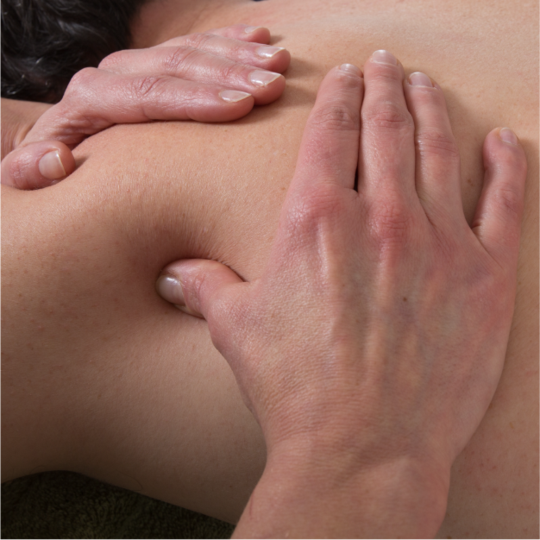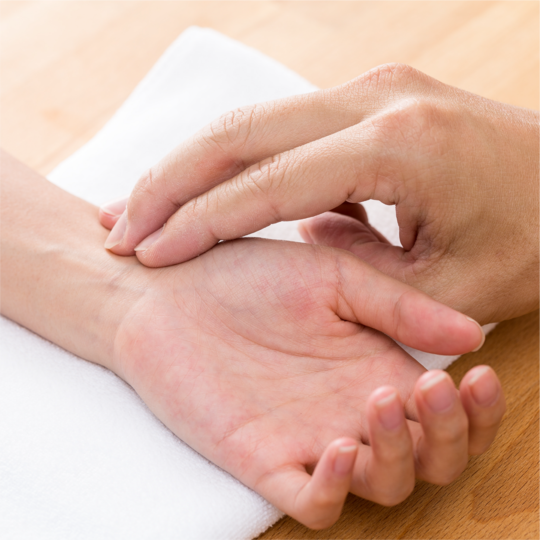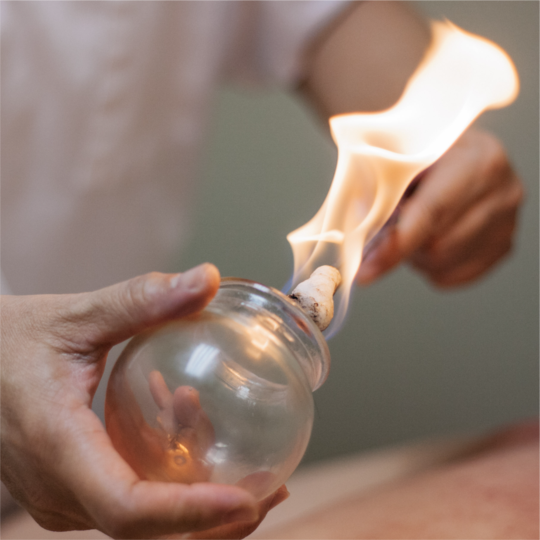Services

針灸治療
針灸以局部刺激氣血循環而逹到治療目的。在患處、痛點或穴位,給予適當的針刺、讓信息傳送到大腦去即時作出調整,將免疫細胞透過血液調動到損傷部位,進行自我修復、調節、止痛、消腫及癒合。
例如肩周炎除了手術外, 西醫多提議物理治療計劃來進行伸展運動。歸根究底, 肩周炎為肩關節活動長期受限引起的疾病,病人可考慮針灸治療,針刺局部穴位,增加局部氣血循環,活血化瘀通絡,從而逹到治療効果。
推拿治療
推拿能使疼痛減輕或消失,在這基礎上人們逐漸認識了推拿對人體的調理作用。一般常用的有推、拿、按、摩、掐、滾、搖、揉、搓、抖等幾個手法。在患者皮膚肌肉的點、線、面上推拿,以疏通患者經絡,滑利關節,促使氣血運行,調整臟腑功能,增強人體抗病能力,從而達到治癒病痛的目的。
骨傷科疾病如扭挫傷、關節脫位、頸椎病、落枕、急性腰扭傷、慢性腰肌勞損、胸脅岔氣、椎間盤突出症、踝關節扭傷、風濕性關節炎、肩周炎及骨折後遺症或內科疾病。感冒、頭痛、胃脘痛、便秘、腹瀉、高血壓、中風後遺症、眩暈、失眠、冠心病與糖尿病等都適用於推拿療法。


正骨復位治療
正骨復位治療主要由註冊中醫師以專業的中醫手法糾正關節的錯位以達到治療和刺激人體的自我修復機制、達到止痛的標本兼治的目的。
接骨治療
如果患者在照過X ray 後知道骨折、可以用中醫接骨復位的方法處理。如果骨斷或骨裂,可用接骨手法,配合固定包紮復原在正確位置。


Cold Moxibustion
Cold moxibustion is a highlight of classical traditional medicine systems incorporating the theories of “Spring and summer nourish Yang, fall and winter nourish Ying” and “Summer’s sickness, winter treat; winter’s sickness, summer treat”.
In the designated seasons (winter and summer), at the designated time (dog days, thirty-nine days), this is the traditional Chinese Medicine method of “midnight-noon and ebb-flow doctrine” therapy to achieve the balance of yin and yang in curing and preventing diseases for optimal health throughout the year.
Cold moxibustion is usually done during the hottest days of the summer (dog days). These three days are known to have the strongest yang energy throughout the year, and the best days for “winter sickness, summer treat”.
The thirty-nine days are the three “nine days” starting from the “winter solstice” in winter. It is also the coldest day in winter. It is the best day for “summer’s sickness, winter treat.
The herbal patch used in the treatment is warming in TCM properties and could promote yang, the TCM provider will apply it to the specific acupuncture points or affected parts of the human body following the TCM clinician’s diagnosis. The herbal patch can stimulate acupoints to increase blood circulation with a warming sensation. Through balancing of the meridian, it can adjust the body’s immune function, improve the phagocytic function of macrophages, increase the immune function of lymphocytes and T cells. At the same time, blood eosinophils and immunogloblins contents are reduced, which significantly calms the body from the allergic state. This exercise acts as a “fire drill” for your immune system, so your body can quickly defend itself and clam itself down when an attack or an irritation occurs.
During the early 60-70s, clinical studies of cold moxibustion have been conducted at a college of Chinese Medicine in Henan Province. At that time, there were many textile factories and coal mines in Henan Province with poor air ventilation associated with high burdens of chronic bronchitis and asthma patients. These patients were treated by various kinds of cold moxibustion with very good recovery rates.
Nowadays in Guangdong and Hong Kong, the humid weather, use of air conditioning, poor air quality and people’s tendency to consume raw and cold foods. Therefore, there are more and more diseases such as fatigue, coldness of the body, allergic constitution, poor respiratory, digestive health, and chronic pain. The benefits of moxibustion therapy are simple, convenient, safe and fast, and the therapeutic efficiency can be up to 80%.
Cite: http://www.nmglib.com:8901/article/detail.aspx?id=1001418239
1. Respiratory system diseases: Respiratory inflammation, throat irritation, common cold
Cold-cold (hyperactive airway) and other symptoms.
Acupoints selection: Dazhui, Dingchuan, Feishu, Shenshu, Gaoxu, Qihai
2. Digestive system diseases: spleen deficiency, lower abdominal pain, diarrhea, poor digestive health
Acupoints selection: Dazhui, Feishu, Shenshu, Pishu, Dachangshu, Guanyuan, Zusanli.
3. Gynecological diseases: menstrual disorders, dysmenorrhea, cold pain in the lower abdomen, dark circles under the eyes.
Acupoint selection: Dazhui, Feishu, Shenshu, Ganshu.
Alternative acupoints: Zusanli, Sanyinjiao, Guanyuan, Qihai, Xuehai, Liangqi
4. Chronic pain: joint swelling and pain, wind-cold arthralgia, neck and back pain.
Acupoint selection: Dazhui, Feishu, Shenshu, Ganshu, Mingmen, Yaoyan.
Lower limbs: Zusanli, Sanyinjiao, Xiexi, knee and eye. Upper limbs: Shoulder, Quchi, Hegu, Yangxi.
5. Sub-health problems: cold limbs, fear of cold, frequent urination, kidney deficiency, insomnia, and fatigue.
Acupoint selection: Dazhui, Feishu, Bladdershu, Ganshu, Shenshu, Mingmen, Zusanli, Sanyinjiao, Guanyuan, Qihai, and Xuehai.
Those with following conditions are not suitable for cold moxibustion
- Acute asthma attack, fever, throat inflammation/break out
- Children under two years old, pregnant women;
- Pulmonary tuberculosis, severe cardiopulmonary insufficiency, diabetic patients, malignant tumors, patients with glucose hexaphosphate dehydrogenase deficiency (G6PD deficiency)
- People with extremely sensitive skin
Precautions
- Warming, burning, redness or blisters on the skin after applying the medicine are normal reactions.
- If blisters appear on the skin, care should be taken to protect the sore surface to avoid infection caused by scratching; if you feel unwell, apply petroleum jelly to relieve skin irritation.
- During the treatment period, you should abstain from eating foods that are prone to inflammation, such as seafood, shrimp, beef, duck, goose and fried food. Eat less cold, spicy, fat, sweet and greasy foods that could produce phlegm and produce dampness, to maximize the therapeutic effect;
- On the day of treatment, cold water should not be applied to the patch site, nor should it be scrubbed with soap;
- If there is any degree of adverse reaction, you can choose to return to our clinic for treatment.
Pulse Taking and Chinese Medicine Prescription
Pulse taking a long history in Chinese Medicine. The Chinese Medicine practitioner will place fingers on the patient’s pulse to interrogate deeply on the patient’s pulse which reflects underlying symptoms and illnesses.
There are four key steps to this. The first step involves checking the patient’s complexion and tongue, while the second step revolves around listening to the patient’s breathing and identify any issues when they cough. The third step is based on the patient explaining the symptoms they have experienced and what treatment they have been using to manage it. Finally, by checking a patient’s pulse, including how strong it is and the general rhythm, medicine can be prescribed accordingly.


Cupping
Cupping is a popular technique that uses the heating of (by fire as most traditional method) small glass cups, to create a suctioning action on the patient’s skin. This causes a confined swelling of the tissue with the goals to improve blood and qi circulation, reduce swollenness and inflammation, and remove dampness (a term used to describe excess water in the body as cause of various types of illnesses). This technique is known for alleviating pain symptoms, it can also be used to improve other cold-related symptoms and illnesses, e.g. wind chill/common cold.
